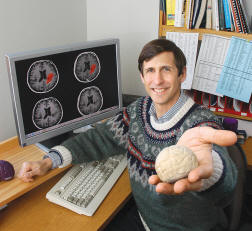|
Another global first for Edmonton
By Michael O'Toole
Photos By: Ellis Brother Photography
Artificial intelligence
may still be widely viewed as the yolky domain of eggheads, spindly
academics bent on establishing that angels can indeed dance on pins.
Nevertheless, as with so
many other latent conveniences in life, most of us rely on this
often invisible task facilitator everyday, but seldom have the grace
to say thank you. This is particularly regrettable when we consider
that AI is perhaps the one algorithm that might actually have the
wits to appreciate the gesture.
“The exciting thing is
that artificial intelligence is real,” declares Dr. Russ Greiner
from the University of Alberta’s AI research unit—a man whose mild
resentment of the egghead label does not prevent him from
fraternizing forgivingly with representatives of his own species.
“People are making money from it. It’s not just an academic exercise
or a frivolity. Part of our mandate is to get business interested in
what we’re doing.”
Greiner’s speciality of
machine learning is itself a vast, seemingly limitless sub-category
of AI predicated on the effort to detect patterns and make decisions
based on those patterns. “Organizations that employ artificial
intelligentsia—machine learning (ML) people—to solve problems do so
because there’s no other technology that works for these problems,”
Greiner asserts.
It seems there are three
main situations where this typically holds good: 1) when nobody
knows the answer; 2) when people know the answer but can’t
articulate it; and 3) when the answer may be known and easy to
articulate, but it’s just too cumbersome to keep redoing the task.
Spam filtering is a choice candidate in the last category, while
healthcare, a key focus of Greiner’s research efforts, is a major
potential beneficiary in the first scenario.
“What genes are
associated with this disease? The way ML approaches this is to build
a classifier. You give me lots of data. Give me 100 patients who’ve
been at the same hospital… 50 patients have the disease and 50
don’t. Tell me their name, age, gender, smoking history, maybe their
genotype. Then I’ll find patterns, or my algorithms will find
patterns.”
| Greiner’s
algorithms, with the help of the Alberta Ingenuity Centre for
Machine Learning are currently partnering with the Cross
Cancer Centre in Edmonton, divining patterns that will
identify patients who should respond well to a certain form of
treatment. The research is wide ranging and, in some respects,
groundbreaking. “My team has built the world’s best analyzer
of brain tumors—the world’s best, right here. This is a
project that people at MIT and McGill have tried to solve, and
we solved it by using machine learning techniques. And that’s
real data, real concerns, real interests—a project which makes
a difference.” |
 |
Beyond medical science,
the pattern-finding capability of ML—and its AI cousins —makes it a
key component of credit card security, e-commerce, delivery routing,
load level prediction in the energy industry and a whole array of
business applications that fall mostly under the umbrella of
business intelligence. Internet search applications alone are
legion.
So who should be talking
to Greiner and his colleagues?
“Anybody who has data.
Try to find me a business sector that doesn’t have a gigabyte or two
sitting around and problems to solve. We’re trying to get people
excited about this. In fact, we are already an international player.
We have collaborations around the world. Edmonton’s been a harder
sell. It’s frustrating for me because we’ve got such a great answer
and there are so many applications that can use it.”
An Edmontonian long
since sold on the proposition is Celcorp’s founder and chief
technology officer, Bruce Matichuk, one of the region’s most vocal
and prolific champions of artificial intelligence and its power to
leverage business operations. His own company, which specializes in
systems integration, is already a veteran exploiter of the
technology.
Donning his industry
cheerleader hat, though, Matichuk turns to the more mall-friendly
realm of video games. “If you look at revenue worldwide, currently
the pc games industry alone makes more than Hollywood, so it’s
absolutely gargantuan and doubling in size regularly. At the core of
many of these games are things called AI engines.” These, Matichuk
expands, are all of the code and algorithms that make you, the
player, think that you’re interacting with another person—a
character that is actually using reasoning to decide what its next
best move is.
Encouragingly, Edmonton
is by no means a passive observer in this massive playpen. Sponsored
by the Alberta Ingenuity Fund, the University of Alberta proudly
sports an electronic entertainment and games research centre
described by Greiner as the strongest in the world. “We’ve
contributed ideas to Electronic Arts to help them debug their
programs by using our technology,” says Greiner. “That’s been very
effectively used.”
Also a key partner is
the high profile Edmonton games producer BioWare, which is currently
harnessing the power of AI in world class products like Baldur’s
Gate.
So much for the
software. What about technology you can really roll around in the
mud with? Michael Bowling, another jovial star of the U of A’s AI
research hub, is proud to represent robots of all shapes,
personality types and political leanings. As if they can’t speak for
themselves.
“There certainly is a
fairly heavy industry associated with robotics,” Bowling points out,
“but artificial intelligence in robotics is still fairly
undeveloped, so it’s unclear what the market looks like yet. One of
the things I’m interested in is to push the intelligence and
understanding of our world enough that we can start deploying robots
in more situations where it wouldn’t be cost effective to have a
human monitor it.”
 |
With
this in mind, Bowling is currently involved in geo caching
research that requires a mobile robot to find a hidden object
by using GPS coordinates and its own precocious talent for
acquiring street savvy. “How do we build a map of our
environment, especially an unstructured environment?” Bowling
posits. “There has been a lot of research on how to do this
inside of buildings. But now, try to take that same technology
and move it outdoors. It doesn’t quite work so well. With its
sensors, it has to figure out that this is drivable terrain,
this is not, or maybe this is risky and if I can’t figure out
any other way to go then maybe I should drive over
this.” |
Among the future
applications of AI robotic technology, Bowling sees huge potential
within the oil and gas industries, where it currently makes no
financial sense to send humans to carry out inspections of
facilities on a regular basis.
In common with other
areas of artificial intelligence, though, entertainment appears to
be the motor zone. The latest incarnation of Sony’s celebrated AIBO
Dog can recognize a 1700-word vocabulary and incorporates learning
techniques to mimic canine behaviour so you can watch your robotic
dog ‘grow up’. The dogs are among several robot types that regularly
compete in the four separate AI soccer leagues at the U of A—all,
despite the chuckles of onlookers, as a testbed for various sober,
practical applications of the underlying technology. While Sony is
turning its attentions elsewhere, Bowling will continue improving
AIBO hardware to solve general problems.
“The reason AI in
robotics is not as big as I think it will be in future is that
robots are still a little bit expensive,” Bowling concludes. “As the
price of robots goes down, that will change.”
Within the artificial
intelligence industry as a whole, image problems linger. “AI as a
field has made some huge blunders over the last several decades,”
Greiner reflects ruefully. “We’ve had, unfortunately, some
charlatans, which makes everyone call into question anything we
say.”
Matichuk shares the
concerns about public perceptions, also finding irony in the fact
that as soon as the technology actually becomes useful, people don’t
think of it as artificial intelligence any more. Though this
societal mindset can be a hindrance from a marketing perspective,
Matichuk takes heart in observing, just a little quirkily, that
“these algorithms are finally getting out of the research labs and
into products that people are using every day.”
| 
